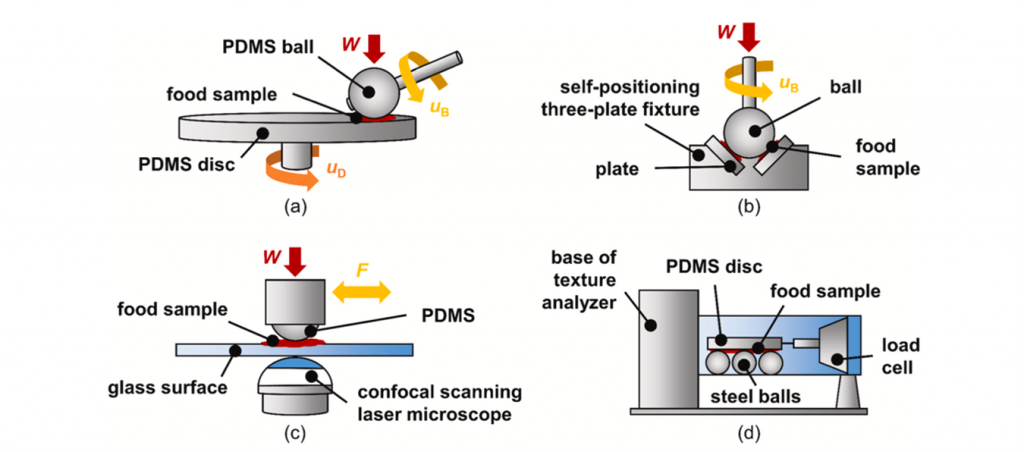Andreas Rosenkranz, Max Marian, Raj Shah, Blerim Gashi, Stanley Zhang, Edmundo Bordeu, Natalia Brossard
1. Introduction
Oral tribology receives growing attention in the field of food sciences as it offers great opportunities to establish correlations between physical parameters, such as the coefficient of friction (COF), and sensory effects when interacting with components of the human mouth.
Considerable research in oral tribology is related to the astringency sensation produced by wine. This is no taste but describes the sensation of dryness and puckering in the mouth, specifically occurring between the tongue and the palate after swallowing [1,2]. Due to the complexity of saliva and its interactions with foods and beverages, a sole mechanism accurately describing the ongoing effects is yet to be established. However, three different hypotheses exist: 1) Soluble tannin-protein aggregates deplete the salivary film and expose the oral pellicle; 2) The formation of precipitated tannin-protein aggregations or 3) Interactions between free-tannins and cell membranes of the oral cavity [3–6] (Figure 1).

Some successful cases reported the potential of correlating wine astringency perception with the COF in tribological experiments. No doubt exists that an established connection between the COF and astringency would allow wineries to quantify astringency based on this experimental parameter rather than utilizing a trained taste-test panel, which can be costly and time consuming.
This overview seeks to compile the characterized mechanisms of astringency and highlight the prevalence of friction as an underlying physiological cause for sensory perception. Technical data depicting the potential correlation between astringency perception and friction are also presented.
2. Tribological instrumentation and Oral mimicking technologies
Oral tribology primarily focuses on the COF between the tongue and the tissue lining of the oral cavity, more specifically the oral epithelium surface. The lubricant responsible for determining the COF is saliva, more specifically, the salivary pellicle layer, which coats the mouth.
A prominent research challenge in oral tribology relates to the design of appropriate tribopairs and lubricants, which effectively mimic oral conditions. To mimic oral tribopairs, polydimethylsiloxane (PDMS) has been widely utilized. Another material not as commonly used in technical research, but with great promise, is whey protein-isolate gels. In terms of mimicking human saliva, the review by Sarkar et al. [7] explored the differences and similarities in properties between human saliva and promising mimetic fluids, specifically porcine gastric mucins (PGM) and bovine submaxillary mucin (BSM). Importantly, specific artificial saliva that mimics astringency perception is still lacking.
Properly designed instrumentation is also important in producing relevant and accurate results in oral tribology. Several tribometers being capable of evaluating the frictional behavior under different contact conditions and sliding speeds are summarized in Figure 2. Notable distinctions between these setups include the range of sliding speeds, tribopair materials, and type of motion (sliding/rolling/reciprocating) [8].

3. Linking sensory perception of astringency to the COF, Current challenges and future perspectives
As the perception of astringency may be directly caused to reduced lubrication by polyphenol-PRP (Proline Rich Proteins) precipitation and insolubility or the degradation of the salivary pellicle, the COF may be a vital indicator of astringency. If a direct relationship could be established, rather than utilizing a trained test panel to determine the astringency effect of a particular wine, wine producers would be able to measure the wine’s COF, thus accurately relating this physical parameter to their quantity to the perception. This has represented a major challenge in the field of oral tribology, primarily due to the complexity of the aforementioned mechanisms for astringency.
Brossard et al. [9], Laguna et al. [10], Wang et al. [11] and Edmonds et al. [12] all attempted to correlate astringency perception to the COF. Brossard et al. [9] utilized a PDMS-steel tribopair, which is not as effective as PDMS-PDMS at simulating oral conditions. Additionally, a greater sample size and range of sliding speeds, similar to the tongue speed range (≤200 mm s− 1), would offer more reliable results. Laguna et al. [10] were limited in not utilizing human saliva in wine- mixture tribological testing, although it is exceedingly difficult to obtain such large amounts of human saliva required for experimentation. Wang et al. [11] and Edmonds et al. [12] utilized model wine samples, which hardly reproduce the complexity of the wine matrix. Wine-saliva ratios closer to the astringency perception (after swallowing) would offer better mimics of oral conditions. However, these conditions are difficult to reproduce since they require large volumes of saliva.
Numerous challenges in methodology and experimental setup makes establishing transferable results a challenge in oral tribology. First, PDMS is an elastomer that both approaches utilized to mimic oral conditions during tribological testing. However, PDMS is susceptible to surface wear during experimentation, which can greatly affect the obtained results [13]. This directly asks for more research towards this direction and the exploration of other materials including whey protein-isolate gels [14]. Additionally, in terms of saliva used for lubrication and/or simulation purposes, aggregation and physicochemical properties of mucins vary significantly across the different studies, which may be connected to a different purity [7]. More attention must be paid to the quality of mucin during experimentation, and a standardization of optimal simulated saliva should remain a paramount focus in future research. Likewise, the variation of the used tribometers, specifically related to the utilized tribopairs and working conditions including contact load, and sliding speed, makes the comparison of different studies rather complicated. Sarkar et al. [8] emphasized that the reproduction of tribological results is necessary across different labs to ensure that any tribology-sensory relationships will not be specific to one set of experimental conditions.
Although most work has been done by experiments, numerical modelling approaches may greatly contribute to a better understanding of the processes and/or mechanisms thus strengthening the underlying hypotheses and drawn conclusions. Additional physically relevant parameters, including viscosity and particle size, may also provide aid in understanding proposed mechanisms and tribology-sensation relationships.
Finally, experimental standardization in mimetic saliva fluid and tribometers, as well as the incorporation of analysing multiple physical parameters serve as prospective goals for the enhancement of reproducibility in results as well as future success in oral tribological research.
The full publication can be found as:
Rosenkranz, A., Marian, M., Shah, R., Gashi, B., Zhang, S., Bordeu, E. and Brossard, N., 2021. Correlating wine astringency with physical measures–Current knowledge and future directions. Advances in Colloid and Interface Science, p.102520.

Andreas Rosenkranz 
Max Marian 
Natalia Brossard 
Andreas Rosenkranz is a Professor for Materials-Oriented Tribology and New 2D Materials in the Department of Chemical Engineering, Biotechnology and Materials at the University of Chile. His research focuses on the characterization, chemical functionalization, and application of new 2D materials. His main field of research is related to tribology (friction, wear, and energy efficiency), but in the last couple of years, he has also expanded his fields towards water purification, catalysis and biological properties. He has published more than 100 peer-reviewed journal publications, is a fellow of the Alexander von Humboldt Foundation and acts as a scientific editor for different well-reputed scientific journals including Applied Nanoscience and Frontiers of Chemistry.
Max Marian is Academic Council at the Engineering Design Institute of Friedrich-Alexander-University Erlangen-Nuremberg (FAU), Germany. His research focuses on energy efficiency and sustainability through tribology, with an emphasis on the modification of surfaces through micro-texturing and coating technologies, for example using molybdenum disulfide, amorphous carbon or MXenes. Besides machine elements and engine components, he expanded his fields towards biotribology and artificial joints. His research is particularly related to the development of numerical multiscale tribo-simulation and machine learning approaches. He has published more than 20 peer-reviewed journal publications and is a member of the German Society for Tribology.
Natalia Brossard is a Professor for winemaking and food quality in the Department of Fruit Production and Enology at the Pontifical Catholic University of Chile. Her research focuses on the wine mouthfeel, chemical characterization of polyphenols, and food oral processing. Her main field of research is related to wine mouthfeel, astringency and oral tribology (prediction of sensory descriptors by physical methods). She is advisor to the Wines of Chile R+D+I Consortium and acts as a scientific editor for different well-reputed scientific journals, including Frontiers of Chemistry and the International Journal of Agriculture and Natural Resources.
References
- McRae JM, Falconer RJ, Kennedy JA. Thermodynamics of grape and wine tannin interaction with polyproline: implications for red wine astringency. J. Agric. Food Chem. 2010;58(23):12510–8.
- Halsam E, Lilley TH. Natural astringency in foodstuffs–a molecular interpretation. Crit. Rev. Food Sci. Nutr. 1988;27(1):1–40.
- Ma W, Guo A, Zhang Y, Wang H, Liu Y, Li H. A review on astringency and bitterness perception of tannins in wine. Trends Food Sci. Technol. 2014;40(1):6–19.
- Charlton AJ, Baxter NJ, Khan ML, Moir AJG, Haslam E, Davies AP, et al. Polyphenol/peptide binding and precipitation. J. Agric. Food Chem. 2002;50(6): 1593–601.
- Lee CA, Ismail B, Vickers ZM. The role of salivary proteins in the mechanism of astringency. J. Food Sci. 2012;77(4):C381–7.
- Furlan AL, Castets A, Nallet F, Pianet I, Gr ́elard A, Dufourc EJ, et al. Red wine tannins fluidify and precipitate lipid liposomes and bicelles. A role for lipids in wine tasting? Langmuir 2014;30(19):5518–26.
- Sarkar A, Xu F, Lee S. Human saliva and model saliva at bulk to adsorbed phases – similarities and differences. Adv. Colloid Interf. Sci. 2019;273:102034.
- Sarkar A, Krop EM. Marrying oral tribology to sensory perception: a systematic review. Curr. Opin. Food Sci. 2019;27:64–73.
- Brossard N, Cai H, Osorio F, Bordeu E, Chen J. “Oral” Tribological study on the astringency sensation of red wines. J. Texture Stud. 2016;47(5):392–402.
- Laguna L, Sarkar A, Bryant MG, Beadling AR, Bartolom ́e B, Victoria Moreno-Arribas M. Exploring mouthfeel in model wines: sensory-to-instrumental approaches. Food Res. Int. 2017;102:478–86.
- Wang S, Olarte Mantilla SM, Smith PA, Stokes JR, Smyth HE. Astringency sub- qualities drying and pucker are driven by tannin and pH – insights from sensory and tribology of a model wine system. Food Hydrocoll. 2020;109:106109.
- Edmonds RS, Finney TJ, Bull MR, Watrelot AA, Kuhl TL. Friction measurements of model saliva-wine solutions between polydimethylsiloxane surfaces. Food Hydrocoll. 2021;113:106522.
- Pradal C, Stokes JR. Oral tribology: bridging the gap between physical measurements and sensory experience. Curr. Opin. Food Sci. 2016;9:34–41.
- Joyner HS, Pernell CW, Daubert CR. Beyond surface selection: the impact of different methodologies on tribological measurements. J. Food Eng. 2014; 134:45–58.
- de Wijk RA, Prinz J. Mechanisms underlying the role of friction in oral texture. J. Texture Stud. 2006;37(4):413–27.

